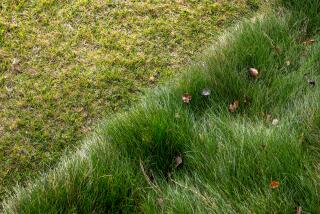Roll out your own green carpet
- Share via
WHILE you might want to think twice before installing 1,000 square feet of sod in the front or back yard, laying 100 feet in a worn parkway or play area is not much harder than rolling out a green carpet. You can bring the sod home yourself since 100 feet will fit in the back of even a compact SUV, avoiding delivery times and charges. Simply find a nursery that will order some for you, then pick it up on the weekend. A few, like Hashimoto Nursery in West Los Angeles, even keep sod on hand.
Look up Southern California sod companies on the Web and see what kinds of grasses they offer. There are many, and each type has its advantages and drawbacks. Consider things like shade, winter cold, summer heat and dogs. Tall fescues such as medallion or marathon are the most common sod grass because they don’t require edging, are green all year and are reasonably tough though they may not be a good choice for people with rambunctious dogs. While doing your grass homework, make a note of suggested mowing heights, which can vary greatly from grass to grass.
Sod can be installed in just about any month, but March is one of the best times because it will take hold quickly in the warming weather and will be firmly rooted by summer. Lawn seed also is best planted now, or in early fall, but it takes six or more weeks before you can even walk on it. Sod can be walked on instantly and is ready for roughhousing in a few weeks.
Laying sod is simple, but the site needs some prep work. “You want to spend your time and effort preparing the soil, ridding it of weeds and fixing the sprinklers,” says Jeffrey Barber of Pacific Sod in Camarillo. “Laying sod is the easy part, like putting together a really simple puzzle.”
Though some will argue the point, sod should be installed over good garden soil, amended if necessary to improve drainage, and free of persistent weeds and old spreading lawn grasses such as Bermuda or St. Augustine. Bermuda can grow right through fescue sod, from old stolons deep underground, conquering the new grass in time. Think Attila the Hun and you get the idea of how tough this invasive grass can be. It’s impossible to dig out every runner and stolon by hand so you’ll have to resort to the systemic herbicide glyphosate (Roundup). Follow the directions carefully and it will kill even the deepest stolons and roots. Or plant Bermuda sod over the old Bermuda lawn.
*
(BEGIN TEXT OF INFOBOX)
Baby sod’s first buzz
It might take a couple of passes the first time you mow new sod. Go easy -- you don’t want to take off too much anyway.
Sod should be rooted and ready for its first mowing in about two weeks. Gently try to lift a corner of the sod to make sure it has begun rooting. Let the lawn dry a little before mowing and check to see that the mower blades are sharp. You don’t want to mow off more than a third of the blade at a time (so the small pieces will disappear in the lawn). It may be necessary to make two or more passes that first haircut, starting at the highest setting on your mower and then lowering it to the proper height for your kind of grass. Some types of hybrid Bermudas are mowed as low as half an inch off the ground, while fescues might be mowed so they end up 3 inches tall.
-- Robert Smaus
*
(BEGIN TEXT OF INFOBOX)
Free labor: yours
Small quantities of sod are more expensive than large but the cost still adds up to very little if you do it yourself. A typical 1-by-5-foot section is a manageable 25 pounds.
Costs for 100 square feet of sod:
Extension for rake: $.99
Box of starter fertilizer: $4
Rental of lawn roller: $10
Sod: $80
Total cost: $94.99






